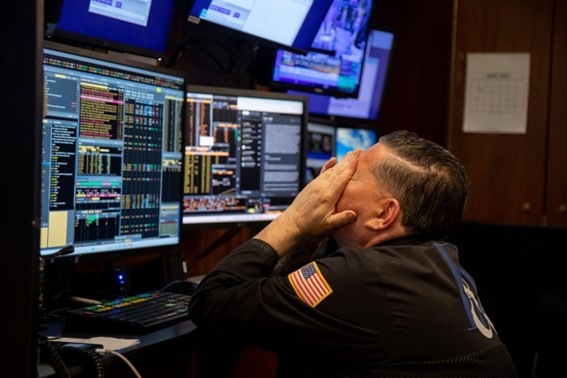
迈克·威尔逊(Mike Wilson)并不害怕在一个通常不会奖励这种行为的行业中脱颖而出。2021年底,这位华尔街资深人士(现任摩根士丹利首席投资官和首席美国股票策略师)认为,在美联储加息和经济增长放缓的双重不利影响下,熊市即将来临——他将二者称为“火”与“冰”。
当时,华尔街的一致预测是,到2022年底,标准普尔500指数将上涨约1%,至4825点,但威尔逊的目标价是同行中最低的,为4400点,而熊市的情况是低于4000点。事实证明,这一悲观预测是正确的,标准普尔500指数去年下跌了约20%,至3839点,威尔逊在《机构投资者》杂志(Institutional Investor)2022年10月的一项调查中获得了顶级股票策略师的荣誉。
但2023年却是另一番景象。
今年1月,这位摩根士丹利首席投资官认为,随着企业盈利增长放缓,标准普尔500指数今年上半年可能会跌至3000点的低点,然后下半年才会回升至3900点。但该指数的表现却恰恰相反,今年迄今为止,由于通胀缓慢消退,以及人们对人工智能作为未来企业增长的潜在驱动因素的热情高涨,该指数上涨了超过12%,达到4300点以上。
不过,尽管其他投资银行已经开始上调蓝筹股指数的目标价,比如高盛集团(Goldman Sachs)现在预计标准普尔500指数今年将收于4500点,高于年初时的4000点,但威尔逊并没有放弃熊市论调。
随着标准普尔500指数反弹超过20%的阈值,越来越多的人宣布熊市正式结束。他在周一的一份报告中写道:“我们尊重大家的观点,但由于对2023年的盈利预测,我们持相反观点。美国仍可能进入熊市。”
威尔逊的基本预测是,标准普尔500指数未来12个月将下跌约3%,至4200点,但在熊市情况下,他认为该指数可能跌至3700点,较当前水平下跌约14%。他认为,股市正处于一场“盈利衰退”之中,而且并未反映在股价中,华尔街的盈利预期过于强劲。
威尔逊周一写道,华尔街对标准普尔500指数中超过70%的成分股的远期盈利预期“至少比新冠肺炎疫情前的水平高出20%”,并指出,即使是摩根士丹利对整体指数的盈利预测——华尔街认为这一预测是看跌的——也“比长期盈利趋势线高出10%”。
威尔逊熊市理论的关键在于,通胀下降将降低企业利润,就像2021年通胀上升有助于增加企业利润一样。正如《财富》杂志此前报道的那样,企业能够在疫情期间转嫁不断上升的成本,提高利润率。但现在,随着通胀下降和经济增长放缓,我们正进入“利润率压缩”的固有周期。
商业情报公司Morning Consult的首席经济学家约翰·莱尔(John Leer)解释说:“驱动利润上升和下降的因素是相同的。已实现的和预期的需求都有所减弱;已实现的和预期的通胀都有所放缓;企业将无法把上涨的成本转嫁给消费者。”
威尔逊周一还表示,高利率正导致经济进入类似二战后的“繁荣/萧条模式”。他解释说,在第二次世界大战和大流行期间,消费者在商品和服务供应受限时期积累了过多储蓄,导致经济重新开放时通货膨胀和股市飙升。随后,在一段时间内,利率不断上升,最终引发了1948年的熊市和经济衰退。但在经济陷入衰退之前,曾出现过一次大规模的熊市反弹,吸引了许多投资者。威尔逊担心,现代投资者正再次落入同样的陷阱。
战后1946年的繁荣过后,标准普尔500指数修正了28%,随后是一轮动荡的熊市反弹(反弹24%,持续了近18个月),一年后跌至新低。到目前为止,这似乎与当前的熊市情况类似,去年股市修正了27.5%,目前已从盘中低点反弹了24%。”他写道。他认为股市投资者可能会面临更多痛苦。(财富中文网)
译者:中慧言-王芳
迈克·威尔逊(Mike Wilson)并不害怕在一个通常不会奖励这种行为的行业中脱颖而出。2021年底,这位华尔街资深人士(现任摩根士丹利首席投资官和首席美国股票策略师)认为,在美联储加息和经济增长放缓的双重不利影响下,熊市即将来临——他将二者称为“火”与“冰”。
当时,华尔街的一致预测是,到2022年底,标准普尔500指数将上涨约1%,至4825点,但威尔逊的目标价是同行中最低的,为4400点,而熊市的情况是低于4000点。事实证明,这一悲观预测是正确的,标准普尔500指数去年下跌了约20%,至3839点,威尔逊在《机构投资者》杂志(Institutional Investor)2022年10月的一项调查中获得了顶级股票策略师的荣誉。
但2023年却是另一番景象。
今年1月,这位摩根士丹利首席投资官认为,随着企业盈利增长放缓,标准普尔500指数今年上半年可能会跌至3000点的低点,然后下半年才会回升至3900点。但该指数的表现却恰恰相反,今年迄今为止,由于通胀缓慢消退,以及人们对人工智能作为未来企业增长的潜在驱动因素的热情高涨,该指数上涨了超过12%,达到4300点以上。
不过,尽管其他投资银行已经开始上调蓝筹股指数的目标价,比如高盛集团(Goldman Sachs)现在预计标准普尔500指数今年将收于4500点,高于年初时的4000点,但威尔逊并没有放弃熊市论调。
随着标准普尔500指数反弹超过20%的阈值,越来越多的人宣布熊市正式结束。他在周一的一份报告中写道:“我们尊重大家的观点,但由于对2023年的盈利预测,我们持相反观点。美国仍可能进入熊市。”
威尔逊的基本预测是,标准普尔500指数未来12个月将下跌约3%,至4200点,但在熊市情况下,他认为该指数可能跌至3700点,较当前水平下跌约14%。他认为,股市正处于一场“盈利衰退”之中,而且并未反映在股价中,华尔街的盈利预期过于强劲。
威尔逊周一写道,华尔街对标准普尔500指数中超过70%的成分股的远期盈利预期“至少比新冠肺炎疫情前的水平高出20%”,并指出,即使是摩根士丹利对整体指数的盈利预测——华尔街认为这一预测是看跌的——也“比长期盈利趋势线高出10%”。
威尔逊熊市理论的关键在于,通胀下降将降低企业利润,就像2021年通胀上升有助于增加企业利润一样。正如《财富》杂志此前报道的那样,企业能够在疫情期间转嫁不断上升的成本,提高利润率。但现在,随着通胀下降和经济增长放缓,我们正进入“利润率压缩”的固有周期。
商业情报公司Morning Consult的首席经济学家约翰·莱尔(John Leer)解释说:“驱动利润上升和下降的因素是相同的。已实现的和预期的需求都有所减弱;已实现的和预期的通胀都有所放缓;企业将无法把上涨的成本转嫁给消费者。”
威尔逊周一还表示,高利率正导致经济进入类似二战后的“繁荣/萧条模式”。他解释说,在第二次世界大战和大流行期间,消费者在商品和服务供应受限时期积累了过多储蓄,导致经济重新开放时通货膨胀和股市飙升。随后,在一段时间内,利率不断上升,最终引发了1948年的熊市和经济衰退。但在经济陷入衰退之前,曾出现过一次大规模的熊市反弹,吸引了许多投资者。威尔逊担心,现代投资者正再次落入同样的陷阱。
战后1946年的繁荣过后,标准普尔500指数修正了28%,随后是一轮动荡的熊市反弹(反弹24%,持续了近18个月),一年后跌至新低。到目前为止,这似乎与当前的熊市情况类似,去年股市修正了27.5%,目前已从盘中低点反弹了24%。”他写道。他认为股市投资者可能会面临更多痛苦。(财富中文网)
译者:中慧言-王芳
Mike Wilson isn’t afraid to stand out from the crowd in an industry that doesn’t often reward that type of behavior. In late 2021, the Wall Street veteran, who is now Morgan Stanley’s chief investment officer and chief U.S. equity strategist, argued that a bear market was on the way amid the toxic combination of Federal Reserve interest rate hikes and slowing economic growth—which he labeled “fire” and “ice.”
At the time, the consensus forecast on Wall Street was for the S&P 500 to rise roughly 1% to 4,825 by the end of 2022, but Wilson’s price target was the lowest of his peers at 4,400, with a bear case of below 4,000. The pessimistic prediction turned out to be correct, as the S&P 500 slipped roughly 20% last year to 3,839, earning Wilson top stock strategist honors in an October 2022 survey by Institutional Investor.
But 2023 has been a different story.
In January, the Morgan Stanley CIO argued that the S&P 500 could drop as low as 3,000 in the first half of the year as corporate earnings growth slowed, before mounting a second half recovery to 3,900. But the index has done pretty much the opposite, rising more than 12% year to date to over 4,300 on the back of slowly fading inflation and enthusiasm for artificial intelligence as a potential driver of future corporate growth.
Still, even as other investment banks have begun to increase their price targets for the blue-chip index—Goldman Sachs, for example, now sees the S&P 500 ending the year at 4,500, up from 4,000 at the start of the year—Wilson isn’t backing down from his bear market thesis.
“With the S&P 500 rally now crossing the 20% threshold, more are declaring the bear market officially over. We respectfully disagree due to our 2023 earnings forecast,” he wrote in a Monday note. “The bear is still alive.”
Wilson’s base case is for the S&P 500 to drop roughly 3% over the next 12 months to 4,200, but in a bear case scenario, he believes the index could fall to 3,700, or around 14% from current levels. He argues that stocks are in the midst of an “earnings recession” that hasn’t been priced in, and Wall Street’s profit expectations are too robust.
More than 70% of S&P 500 sectors have forward earnings expectations from Wall Street that are “at least 20% above pre-COVID levels,” Wilson wrote Monday, noting that even Morgan Stanley’s earnings forecast for the overall index, which is seen as bearish on the Street, is “10% above the long-term earnings trend line.”
The key to Wilson’s bearish theory is the idea that falling inflation will lower corporate profits, just as rising inflation helped to increase them in 2021. As Fortune previously reported, businesses were able to pass on rising costs during the pandemic and increase profit margins. But now, with inflation falling and economic growth slowing, we’re entering a natural period of “margin compression.”
“That’s driven by the same things that made the profits go up, coming down,” explained John Leer, chief economist at business intelligence firm Morning Consult. “You’ve got weaker demand, realized and expected; you’ve got slower inflation, realized and expected; and less ability for businesses to pass along elevated costs to consumers.”
Wilson also argued on Monday that higher interest rates are leading the economy into a “boom/bust regime” like what was seen after World War II. He explained that during both WWII and the pandemic, consumers built up excess savings during a period when the supply of goods and services was constrained, causing inflation and the stock market to surge when the economy reopened. Then a period of higher interest rates followed, which ultimately sparked a bear market and a recession in 1948. But before the economy entered that recession, there was a sizable bear market rally that lured in many investors. Wilson fears modern investors are falling into this same trap again.
“After the boom in 1946 following the end of the war, the S&P 500 corrected by 28%, followed by a 24% choppy bear market rally that lasted almost 18 months before succumbing to new lows a year later. Thus far, this appears similar to the current bear market, which corrected 27.5% last year and has now rallied 24% from the intraday lows,” he wrote, arguing more pain is likely ahead for stock market investors.






